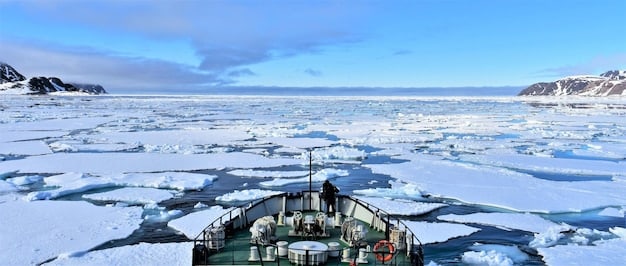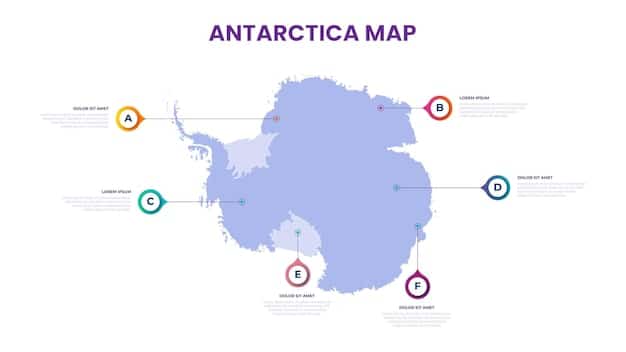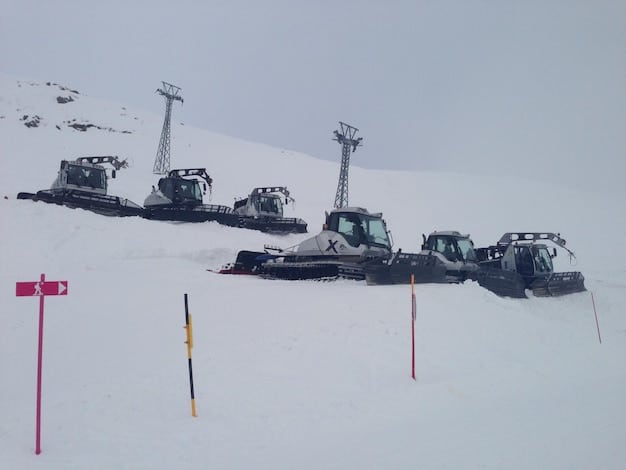US Arctic Policy After Russia’s Buildup: Geopolitical Strategies

US Foreign Policy in the Arctic is currently focused on navigating the complex geopolitical landscape following Russia’s increased military presence, balancing security concerns with environmental protection and international cooperation to maintain stability in the region.
The Arctic is rapidly becoming a focal point of international relations, particularly in light of Russia’s recent military buildup. This article delves into the intricate landscape of US Foreign Policy in the Arctic: Navigating the Geopolitical Landscape After Russia’s Recent Military Buildup, examining the strategies and challenges that the United States faces in this strategically vital region.
The Arctic’s Growing Strategic Importance
The Arctic region, once considered remote and largely inconsequential, has risen to prominence on the global stage. This shift is primarily due to climate change, which has led to melting ice and increased accessibility to the region’s vast natural resources and strategic waterways.
The United States recognizes the Arctic’s growing significance and has been working to develop a comprehensive strategy for the region. This strategy aims to balance competing interests, including national security, economic development, environmental protection, and international cooperation.

The Impact of Climate Change
One of the most significant drivers of change in the Arctic is climate change. As temperatures rise, ice melts, opening up new shipping routes and making it easier to access the region’s natural resources. This has attracted the attention of numerous countries, including Russia, China, and Canada, each of whom have their own interests in the region.
- Opening of Shipping Routes: The Northwest Passage and the Northern Sea Route offer shorter transit times between Europe and Asia, potentially revolutionizing global trade.
- Resource Extraction: The Arctic is estimated to hold vast reserves of oil, gas, and minerals, making it an attractive target for resource extraction.
- Environmental Concerns: Increased human activity in the Arctic poses significant risks to the region’s fragile ecosystem, including pollution, habitat destruction, and the introduction of invasive species.
Climate change also poses a direct threat to Arctic communities, many of whom rely on traditional hunting and fishing practices for their livelihoods. Rising sea levels, melting permafrost, and changing weather patterns are disrupting these practices and forcing communities to adapt.
In conclusion, the ecological and economic impacts of climate change play a crucial role in shaping US Foreign Policy within the Arctic.
Russia’s Military Buildup in the Arctic
Russia has been steadily increasing its military presence in the Arctic in recent years. This buildup includes the reopening of Soviet-era military bases, the deployment of new weapons systems, and an increase in military exercises.
Russia’s actions have raised concerns among other Arctic nations, including the United States, Canada, and Norway. These countries fear that Russia’s military buildup could lead to increased tensions and instability in the region.

Motivations Behind Russia’s Actions
There are several reasons why Russia is investing so heavily in its Arctic military capabilities. First, Russia sees the Arctic as a strategically important region, both for its natural resources and its potential as a transit route for military vessels.
- Resource Control: Russia’s vast Arctic territory holds significant reserves of oil, gas, and minerals, which are crucial to the country’s economy.
- Strategic Positioning: The Arctic provides Russia with a strategic advantage for projecting power into the North Atlantic and the Pacific Ocean.
- National Pride: Russia sees the Arctic as part of its historical and cultural heritage and is keen to reassert its dominance in the region.
Russia also views its military presence in the Arctic as a way to deter potential adversaries from challenging its interests in the region. By demonstrating its willingness to defend its Arctic territory, Russia hopes to discourage other countries from attempting to exploit the region’s resources or use it for military purposes.
Overall, Russia’s military expansion in the Arctic significantly alters the strategic landscape, demanding a measured yet firm response from the US.
US Strategic Objectives in the Arctic
The United States has a number of strategic objectives in the Arctic. These include protecting its national security interests, promoting economic development, preserving the environment, and fostering international cooperation.
To achieve these objectives, the United States is working to strengthen its military presence in the Arctic, develop its economic ties with the region, and promote sustainable development.
Strengthening Military Presence
The United States maintains a limited military presence in the Arctic, primarily focused on Alaska and Greenland. However, the US military is taking steps to enhance its capabilities in the region, including upgrading its infrastructure, conducting more frequent exercises, and deploying new technologies.
The US military is also working to improve its cooperation with other Arctic nations, such as Canada and Norway, to enhance its ability to respond to potential threats in the region.
Promoting Economic Development
The United States is keen to promote economic development in the Arctic, both to benefit its own economy and to improve the lives of Arctic residents. This includes supporting sustainable resource extraction, developing new infrastructure, and promoting tourism.
The United States is also working to encourage responsible investment in the Arctic, ensuring that economic development is carried out in a way that protects the environment and respects the rights of indigenous communities.
In brief, aligning military readiness with sustainable economic strategies forms the core of the US Arctic policy.
Navigating Geopolitical Challenges
The Arctic is a complex and dynamic region, with a number of geopolitical challenges that the United States must navigate. These include managing relations with Russia, addressing the interests of other Arctic nations, and protecting the rights of indigenous communities.
To address these challenges, the United States is working to build strong relationships with its allies, engage in constructive dialogue with Russia, and promote inclusive governance in the Arctic.
The Role of International Cooperation
International cooperation is essential for managing the Arctic effectively. The Arctic Council, which includes the United States, Russia, Canada, Denmark, Finland, Iceland, Norway, and Sweden, is the primary forum for international cooperation in the region.
- Arctic Council: The Arctic Council promotes cooperation on issues such as environmental protection, sustainable development, and scientific research.
- Bilateral Agreements: The United States has bilateral agreements with a number of Arctic nations, including Canada and Denmark, to address specific issues of mutual concern.
- UN Convention on the Law of the Sea (UNCLOS): While the US has not ratified UNCLOS, it generally recognizes it as customary international law, particularly concerning maritime boundaries and resource rights.
The United States is also working to promote the rule of law in the Arctic, ensuring that all activities in the region are conducted in accordance with international law and established norms.
Consequently, embracing multilateralism may prove vital in addressing complex challenges within the region.
Environmental Protection and Sustainability
Environmental protection is a key priority for the United States in the Arctic. The region is home to a number of unique and fragile ecosystems, which are particularly vulnerable to the effects of climate change and human activity.
To protect the Arctic environment, the United States is working to reduce greenhouse gas emissions, promote sustainable resource management, and prevent pollution.
Mitigating Climate Change
Reducing greenhouse gas emissions is essential for protecting the Arctic from the worst effects of climate change. The United States has set ambitious targets for reducing its emissions and is working to transition to a clean energy economy.
The United States is also working to promote international cooperation on climate change, urging other countries to take meaningful steps to reduce their emissions.
Sustainable Resource Management
The United States is committed to promoting sustainable resource management in the Arctic, ensuring that resource extraction is carried out in a way that protects the environment and respects the rights of indigenous communities.
- Environmental Impact Assessments: Conducting thorough environmental impact assessments before undertaking any resource extraction or development projects.
- Best Practices: Adopting best practices for resource management, including minimizing pollution, protecting wildlife habitats, and preventing oil spills.
- Community Involvement: Engaging with local communities in the decision-making process, ensuring that their concerns are taken into account.
Ultimately, sustainability and environmental preservation will become more and more critical to US policy within the Arctic.
The Future of US Arctic Policy
The Arctic is a region of increasing importance, and the United States must be prepared to address the challenges and opportunities that lie ahead. This requires a comprehensive and integrated approach that balances competing interests and promotes long-term sustainability.
By strengthening its military presence, promoting economic development, preserving the environment, and fostering international cooperation, the United States can ensure that the Arctic remains a peaceful, prosperous, and sustainable region for generations to come.
Key Considerations for Policymakers
As the Arctic continues to evolve, policymakers in the United States must consider several key factors when developing and implementing Arctic policy. These include:
- Adaptability: Arctic policy must be adaptable to changing conditions, including climate change, geopolitical shifts, and technological advancements.
- Inclusiveness: Arctic policy must be inclusive, taking into account the interests of all stakeholders, including Arctic nations, indigenous communities, and environmental groups.
- Long-Term Vision: Arctic policy must be guided by a long-term vision, ensuring that decisions made today do not undermine the region’s future sustainability.
By addressing these considerations, the United States can ensure that its Arctic policy remains relevant and effective in the years to come.
In conclusion, a pragmatic and adaptive approach underpins any viable US Arctic strategy.
| Key Aspect | Brief Description |
|---|---|
| 🌍 Climate Change | Melting ice opens new routes and resource access, impacting ecosystems. |
| 🛡️ Military Buildup | Russia’s increased military presence raises security concerns. |
| 🤝 Cooperation | International cooperation is crucial for Arctic governance. |
| 🌱 Sustainability | Balancing development with environmental protection is essential. |
Frequently Asked Questions
▼
The main objectives include protecting national security, promoting sustainable economic development, preserving the environment, and fostering international cooperation in the Arctic region.
▼
Russia’s actions have spurred the US to strengthen its military presence and improve cooperation with allies, enhancing the ability to respond to potential threats in the Arctic.
▼
The Arctic Council is the primary intergovernmental forum promoting cooperation on environmental protection, sustainable development, and scientific research among Arctic states.
▼
Key environmental concerns include the melting of ice, pollution from increased shipping and resource extraction, and the disruption of fragile ecosystems and indigenous ways of life.
▼
Sustainable development requires environmental impact assessments, adopting best practices for resource management, and engaging local communities in decision-making processes.
Conclusion
Navigating the geopolitical landscape of the Arctic in the face of Russia’s military expansion requires a balanced and adaptable approach from the United States. By prioritizing international cooperation, sustainable development, and strategic readiness, the US can help ensure the long-term stability and prosperity of this vital region.





